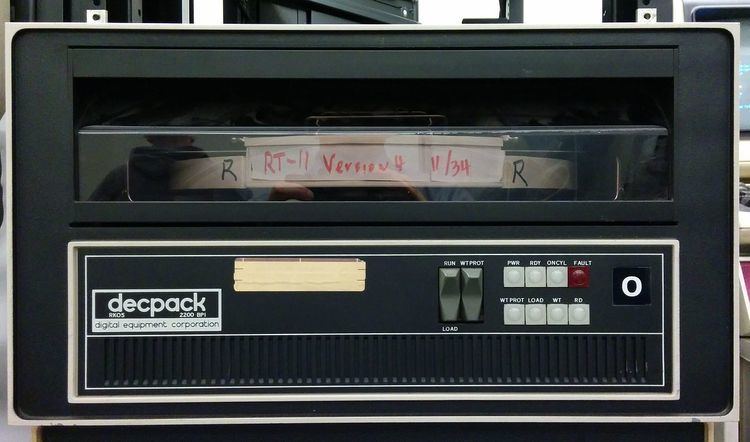 | ||
The RK05 DECpack was a moving head magnetic disk drive manufactured by the Digital Equipment Corporation of Maynard, Massachusetts. It stored approximately 2.5 MB on a 14", single-platter IBM-2315-style front-loading removable disk cartridge. The cartridge permitted users to have relatively unlimited off-line storage and to have very fast access to such data. At the time DEC had numerous operating systems for each computer architecture so operating systems could also be changed quickly. The RK05 was the disk successor to DECtape for personal, portable, and expandable storage. While the smallest practical configuration was two drives, many systems had four or more drives.
Occupying 10.5 inches (6U) of space in a standard 19-inch rack, the drive was competitive at the time. The cartridge contained a single, 14" aluminum platter coated with iron oxide in an epoxy binder. The two ferrite and ceramic read/write heads were pressed towards the disk by spring arms, floating on an air bearing maintained by the rotation of the disk. They were positioned by a voice coil actuator using a linear optical encoder for feedback. The track density was 100 tracks-per-inch. The bit density along the track was about 2200 bits-per-inch. Discrete electronics computed the velocity profile for seeks commanded by the controller. An absolute filter (HEPA filter) provided pressurized air to the cartridge, excluding most contaminants that would otherwise cause head crashes.
When used on 16-bit systems such as the PDP-11, the drive stored roughly 1.2 megawords. When used on 12-bit systems such as the PDP-8, the drive stored 1.6 megawords (so roughly the same bit capacity, albeit formatted differently). Multiple drives were daisy chained from their controller using Unibus cabling; a terminator was installed in the farthest drive.
The 16-bit (Unibus) controller was known as the RK11; it allowed the connection of up to eight RK05 drives. Seeks could be overlapped among the drives but only one drive at a time could transfer data.
The most-common 12-bit (Omnibus) controller was known as the RK8E; it supported up to four RK05 drives. The RK05 disk had more than 4096 sectors and so could not be addressed completely by a single PDP-8 12-bit word. To accommodate this, the OS/8 operating system split each drive into two logical volumes, for example, RKA0 and RKB0, representing the outermost and innermost cylinders of the drive.
